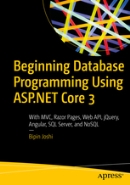
|
Beginning Database Programming Using ASP.NET Core 3
(Apress, December 2019)
Hit the ground running with this book to quickly learn the fundamentals of HTML form processing, user authentication, and database CRUD (Create, Read, Update, and Delete) operations using the ASP.NET Core family of technologies. You will utilize cutting-edge and popular technology options from both the server side and client side to help you achieve your web application goals as quickly as possible.
|

|
Beginning XML with C# 7
(Apress, November 2017)
Master the basics of XML as well as the namespaces and objects you need to know in order to work efficiently with XML. You'll learn extensive support for XML in everything from data access to configuration, from raw parsing to code documentation. You will see clear, practical examples that illustrate best practices in implementing XML APIs and services as part of your C#-based Windows applications. In this book, you’ll discover the integration of XML with ADO.NET and LINQ as well as additional .NET support for today's RESTful web services and Web API. Written by a Microsoft Certified Professional and developer, this book demystifies everything to do with XML and C# 7.
|

|
Beginning SOLID Principles and Design Patterns for ASP.NET Developers
(Apress, March 2016)
This book teaches you all the essential knowledge required to learn and apply time-proven SOLID principles of object-oriented design and important design patterns in ASP.NET 5 (recently renamed ASP.NET Core 1.0) applications. You will learn to write server-side as well as client-side code that makes use of proven practices and patterns. This book contains detailed descriptions of how to apply Creational, Structural and Behavioral GoF design patterns along with some Patterns of Enterprise Application Architecture. Also covered are a few Popular JavaScript code organization techniques and patterns.
|
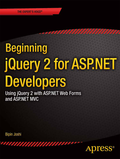
|
Beginning jQuery 2 for ASP.NET Developers
(APress, December 2013)
Beginning jQuery 2 for ASP.NET Developers teaches you to harness the power, versatility and extensibility of jQuery in your ASP.NET Web Forms and ASP.NET MVC applications. By combining jQuery with ASP.NET you get the best of both worlds: the client-side interactivity and responsiveness of JavaScript with the robustness and extensibility of Microsoft's web stack. Beginning jQuery 2 for ASP.NET Developers shows you how.
|
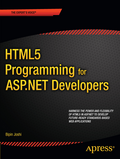
|
HTML5 Programming for ASP.NET Developers
(APress, November 2012)
HTML5 Programming for ASP.NET Developers teaches you to harness the power and flexibility of HTML5 in your ASP.NET Web Forms and ASP.NET MVC applications. Focusing on the programmable features of HTML5 that will be most useful to you as an ASP.NET developer, this book will take you straight to the heart of what you can get out of this new technology.
|

|
नाथ संकेतींचा दंशु
(फेब्रुवारी २०१५)
कुंडलिनी योगमार्ग विनाकारण गुढतेच्या आणि क्लिष्टतेच्या वलयात झाकोळला गेला आहे. सर्वसामान्य संसारी साधक कुंडलिनी योगमार्गापासून दूरच राहिला आहे. कुंडलिनी योगमार्गाच्या अनेक परंपरा आहेत. त्यांच्या साधनामार्गातही भिन्नता आहे. या सर्व पसार्यातून सर्वसामान्य साधकाला समजतील, जमतील आणि फायदा मिळवून देतील अशी मूलतत्वे आणि साधना यांचे सहज सोप्या भाषेत विश्लेषण करणे हे या पुस्तकाचे मुख्य उद्दीष्ट आहे.
|

|
शिवोपासना
(मार्च २०११)
भारतवर्षामधे अनादी काळापासून शिवोपासना आणि योग प्रचलित आहे. कूर्म पूराणात निःसंदिग्धपणे असे सांगितले आहे की शंकर हे कलियुगातल्या मानवांसाठीचे दैवत आहे. शिव उपासनेचे योगमार्गावरील महत्व, शिवलिंग, पुजा इत्यादींचा योगशास्त्रीय अर्थ, शैव दर्शनाची मुलतत्वे, रुद्राक्षधारण विधी, कालसापेक्ष शिव उपासना कशी करावी इत्यादी गोष्टी सोप्या भाषेत विशद करणारे पुस्तक.
|

|
देवाच्या डाव्या हाती
(प्रथम आवृत्ती - मार्च २००९, द्वितीय आवृत्ती - ऑक्टोबर २०११, तृतीय आवृत्ती - फेब्रुवारी २०१७)
कुंडलिनी योग अध्यात्म जीवनाचा राजमार्ग आहे. जगदंबा कुंडलिनीला जागृत करून तीचे सहस्रार स्थित शिवाशी सामरस्य घडवून आणणे हे कुंडलिनी योगमार्गाचे मुलतत्व. अनेकदा कुंडलिनी योग गूढतेच्या अनावश्यक धुक्याने वेढलेला आठळतो. हा मार्ग फक्त जंगलात वा हिमालयात वास्तव्य करणार्या योग्यांसाठीच आहे असा गैरसमज बहुतांशी लोकांमधे आढळतो. देवाच्या डाव्या हाती' या पुस्तकात श्री. बिपीन जोशी यांनी स्वतःचे कुंडलिनी योगमार्गावरील अनुभव विषद केले आहेत. एक नवखा साधक ते योगी या प्रवासात त्यांना कोणत्या अडचणी आल्या, त्यांनी मोठ्या जिद्दीने हा प्रवास कसा पार केला याचे प्रभावी वर्णन या पुस्तकात आढळते.
|
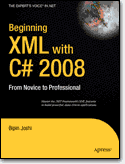
|
Beginning XML with C# 2008: From Novice to Professional
(APress, April 2008)
Beginning XML with C# 2008 focuses on XML and how it is used within .NET 3.5. As you’d expect of a modern application framework, .NET 3.5 has extensive support for XML in everything from data access to configuration, from raw parsing to code documentation. This book demystifies all of this. It explains the basics of XML as well as the namespaces and objects you need to know in order to work efficiently with XML. You will see clear, practical examples that illustrate best practices in action. With this book, you’ll learn everything you need to know from the basics of reading and writing XML data to using the DOM, from LINQ and SQL Server integration to SOAP and web services.
|
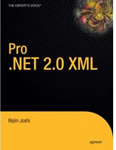
|
Pro .NET 2.0 XML
(APress, April 2007)
XML is the de facto language for communication within and between distributed applications, whether they are on the Internet or a corporate network. XML is successful because of two strengths: it has a highly-structured human readable format and it can be transmitted as pure text. No matter how disparate applications and their architectures may be, text files can always be read, and therefore can accept XML data. This makes XML-based solutions advantageous over rival technologies like remoting. Pro .NET 2.0 XML is the first book to provide a complete solution to XML on the .NET Framework 2.0 including the new .NET 3.0 extensions that are being released in January 2007. It provides you with everything you need to know to take advantage of XML in every aspect of your job including integration with Windows Communication Foundation.
|

|
Developer's Guide to ASP.NET 3.5
(BinaryIntellect Consulting, November 2007)
This book is about ASP.NET 3.5. It teaches you most of the concepts that you need to make yourself up and running with ASP.NET 3.5. It looks at ASP.NET 3.5 as a complete platform for web application development. You will find many topics that are equally applicable in ASP.NET 1.x and 2.0 also. Care has been taken that you need not refer any 1.x or 2.0 book for understanding the concepts. Master ASP.NET 3.5 development using C# and Visual Studio.NET 2008. Learn ASP.NET from ground up. Design professional looking web sites with server controls, Master Pages and Themes. Develop data driven web forms with ADO.NET and data bound controls. Secure your web application with Membership and Roles. Develop AJAX spiced web sites. Write ASMX and WCF services. Understand the configuration, compilation and deployment techniques.
|
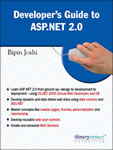
|
Developer's Guide to ASP.NET 2.0
(BinaryIntellect Consulting, November 2005)
Since Microsoft introduced ASP.NET the overall web application development is revolving around ASP.NET as far as Microsoft product based solutions are concerned. ASP.NET brought a major shift in the way applications are built and deployed. Web applications suddenly became so rich and powerful! Continuing the same wave further Microsoft has introduced ASP.NET 2.0. The new version is totally backward compatible with ASP.NET 1.x. However, it introduces some major enhancements and
additions. While building version 2.0 the goal of ASP.NET team within Microsoft has been to reduce the amount of code that developers are writing today to a great degree. Version 2.0 brings more than 40 new controls and provides many new classes and concepts. With these additions ASP.NET 2.0 is poised to be stronger, flexible and powerful than ever before. This book is about ASP.NET 2.0. It teaches you most of the concepts that you need to make yourself up and running with ASP.NET 2.0. There are books that cover just the new additions to ASP.NET infrastructure. This book is different. It looks at ASP.NET 2.0 as a complete platform for web application development. You will find many topics that are equally applicable in ASP.NET 1.x also. Care has been taken that you need not refer to any 1.x book for understanding the concepts.
|
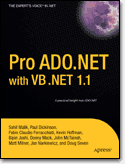
|
Pro ADO.NET with VB .NET 1.1
(APress, November 2004)
Calling all VB .NET programmers and web developers! This highly anticipated book provides thorough instruction for using ADO.NET, supported with numerous relevant code examples and extensive technical information. So whether you're developing web applications using ASP.NET, Windows Forms applications, or XML Web Services, you will become adept at maximizing .NET's data access technology. Topics include: ADO.NET data architecture; data readers, adapters, and DataSets; safer development with XML Schemas; data relationships; and ADO.NETs built-in support and performance optimization. With such valuable content, you will come to master a solution-oriented approach to ADO.NET.
|
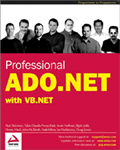
|
Professional ADO.NET with VB.NET
(WROX Press, December 2002)
ADO.NET is Microsoft's latest data access technology and, as an integral part of the .NET Framework, is far more than just an ADO upgrade. ADO.NET provides an extensive set of .NET classes that facilitate efficient access to data in a large variety of sources, enable sophisticated manipulation and sorting of data, and form an important framework within which to implement inter-application communication. This book provides a comprehensive guide to using ADO.NET, with plenty of practical code examples and extensive technical information. Whether you're developing web applications using ASP.NET, Windows Forms applications, or XML Web Services, this book will show you how to use .NET's data access technology to maximum effect. Along the way, it looks at: Understanding the architecture of the ADO.NET data providers, Reading and writing data with data readers, data adapters and DataSets, Making development safer with XML Schemas and strongly typed DataSets, Defining constraints on and relationships between your data, Using ADO.NET's built-in support for transactional processing, Optimizing the performance and security of your ADO.NET applications, Developing your own data provider for a custom data source.
|
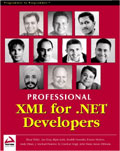
|
Professional XML for .NET Developers
(WROX Press, December 2001)
XML is now an established technology for the description and transportation of data, and has made a major impact on almost every aspect of software development. When Microsoft introduced the .NET Framework, they took advantage of XML wherever they could. No other technology is so tightly bound with .NET as XML, both at the developer level and underlying the whole framework. This book aims to give the reader enough information to be able to use XML from within the .NET Framework in the most efficient manner possible. It will explain in detail the usage of all the XML-related .NET Framework library classes for the manipulation, validation, transformation, and serialization of XML data, using both C# and Visual Basic .NET. It also looks at how the developer can utilize the full power of XML within the .NET Framework, for example, with the new XML capabilities of ADO.NET and ASP.NET. As is demonstrated, the .NET Framework itself uses XML, in configuration files, meta data, and C#'s XML code documentation mechanism, for example. This book is aimed at intermediate-level programmers who have started on their journey towards .NET development, and who want to see how to use XML within their applications to its best advantage. Basic knowledge of C# or Visual Basic .NET, XML, and XML related technologies (XSLT, XPath, and XML Schemas) is necessary.
|
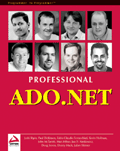
|
Professional ADO.NET
(WROX Press, November 2001)
ADO.NET is Microsoft's latest data access technology and, as an integral part of the .NET Framework, is far more than simply an upgrade of previous incarnations of ADO. ADO.NET provides an extensive set of .NET classes that facilitate efficient access to data from a large variety of sources, enable sophisticated manipulation and sorting of data, and forms an important framework within which to implement inter-application communication and XML Web Services. This book provides a comprehensive guide to using ADO.NET, with plenty of practical code examples, extensive technical information, and a detailed case study. Whether you are developing Web Applications using ASP.NET, Windows Forms applications, or XML Web Services, this book will show you how to utilize .NET's data access technology to maximum effect.
|